
The fascinating world of bees is a captivating subject for many. Have you ever wondered how a bee’s anatomy plays a vital role in its lifestyle? From the buzz of their wings to the sting on their backside, every part of a bee has a purpose. From their compound eyes to their hairy bodies, join us as we explore the intricate detailing of a bee’s anatomy and how it supports their incredible lifestyle. Get ready to be amazed by the intricate design of these incredible creatures.
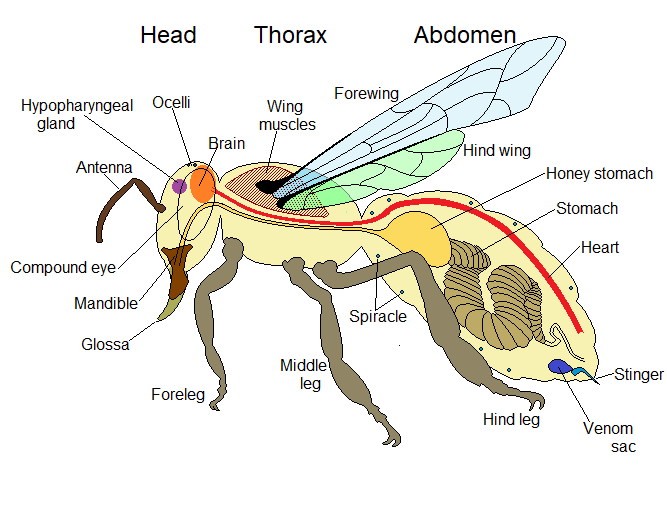
This image is property of www.northdorsetbeekeepers.org.uk.
1. Body Structure
1.1 Exoskeleton
As a bee, you have a unique body structure that includes a tough outer covering known as an exoskeleton. This exoskeleton serves as a protective layer and provides support to your delicate internal organs. Made of a substance called chitin, it is lightweight yet strong, allowing you to navigate through various environments with ease.
1.2 Three Body Segments
Your body is divided into three distinct segments: the head, thorax, and abdomen. Each segment has its own specific functions and is essential for your survival. The head houses your sensory organs, such as compound eyes and antennae, while the thorax is responsible for housing your flight muscles and legs. Finally, the abdomen contains vital organs such as the digestive system and reproductive organs.
1.3 Head
The head of a bee is a fascinating structure that houses several important features. One of the most prominent features is your compound eyes, which are composed of many individual lenses. This allows you to have a broad field of vision and detect movement in your surroundings. Additionally, you have ocelli, which are simple eyes that help with navigation and orientation.
1.4 Thorax
The thorax is the middle segment of your body and plays a crucial role in your ability to fly. It is equipped with powerful flight muscles that enable you to beat your wings rapidly and generate enough lift to stay airborne. These muscles are attached to your exoskeleton and contract and relax in a coordinated manner, allowing for efficient flight maneuvers.
1.5 Abdomen
Your abdomen contains various essential organs that support your overall well-being. The digestive system, consisting of the foregut, midgut, and hindgut, helps break down food and extract nutrients. Your reproductive system is also located in the abdomen, with different types of bees having specific roles in the colony, such as the queen bee, drone bee, and worker bees.
2. Wings and Flight
2.1 Forewings and Hindwings
Your ability to fly is attributed to the presence of forewings and hindwings. These wings are transparent and membranous, allowing for efficient airfoil movement. They are interconnected by a row of tiny hooks, ensuring coordinated wing beats during flight.
2.2 Flight Muscles
The thorax of a bee houses the powerful flight muscles responsible for wing movement. These muscles contract and relax rapidly, generating the necessary force to propel you through the air. The energy for this constant wing beats is provided by the metabolic breakdown of stored sugars in your body.
2.3 Wing Beats
Your wings beat at an astonishing rate, typically around 200 times per second. This rapid wing movement creates a buzzing sound that is often associated with bees. The precise control of these wing beats allows you to hover, maneuver, and navigate between flowers, supporting your foraging and pollination activities.
3. Sensory Organs
3.1 Compound Eyes
Your compound eyes are truly remarkable sensory organs. Comprising numerous individual lenses, they provide you with an excellent panoramic view of the world around you. This broad field of vision helps you detect predators, identify potential food sources, and communicate with other members of your colony.
3.2 Ocelli
In addition to compound eyes, you possess ocelli, which are simple eyes located on the top of your head. Although they cannot provide detailed images like compound eyes, ocelli are highly sensitive to light intensity and help you navigate by detecting changes in brightness. This helps you maintain stable flight and orientation, even in low light conditions.
3.3 Antennae
Your antennae serve as your primary sense of touch and smell. Equipped with sensory hairs and receptors, they allow you to detect chemical signals called pheromones, which are crucial for communication within your colony. Additionally, your antennae help you locate food sources, navigate, and explore your surroundings.
4. Mouthparts
4.1 Mandibles
Your mouthparts, known as mandibles, are powerful and specialized structures that are primarily used for chewing. They enable you to collect and process various food sources, such as floral nectar, pollen, and even plant resins. The mandibles are also crucial for constructing the cells within the hive and defending the colony against intruders.
4.2 Proboscis or Tongue
In addition to your mandibles, you have a proboscis or tongue. This elongated, straw-like structure allows you to extract nectar from flowers. By extending and retracting your proboscis, you can reach deep into floral structures to access the sweet rewards within. It’s an efficient tool for gathering the energy-rich nectar, which you convert into honey.
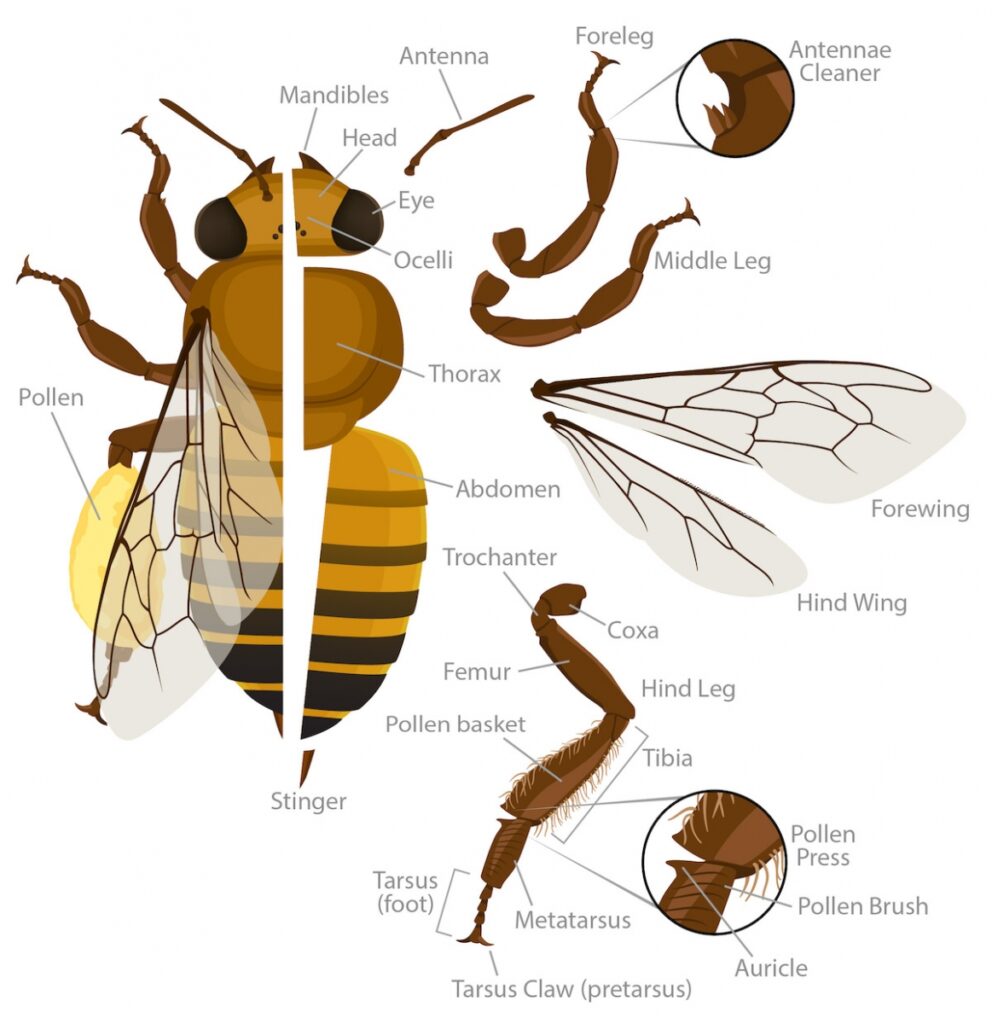
This image is property of askabiologist.asu.edu.
5. Legs and Feet
5.1 Three Pairs of Legs
Like other insects, you have three pairs of legs for walking, gripping, and supporting your body. Each leg is composed of several segments, including the coxa, trochanter, femur, tibia, and tarsus. These segments work together, allowing you to navigate different surfaces with ease.
5.2 Structure of the Legs
Your legs are equipped with specialized structures that aid in your survival and day-to-day activities. These include spurs and brushes that help collect pollen, enabling you to transport it back to the hive for food storage. You also have specialized structures called pollen baskets, located on the sides of your hindlegs, which serve as convenient storage compartments for pollen as you forage.
5.3 Pollen Baskets
Pollen baskets, also known as corbiculae, are concave regions surrounded by stiff hairs. When you collect pollen from flowers, you pack it into these baskets, allowing you to transport large amounts efficiently. The pollen is then taken back to the hive, where it serves as a vital food source for the colony.
5.4 Claws and Pads on the Feet
Your feet are equipped with claws and pads that enhance your grip on various surfaces. The claws help you hold onto flowers, while the pads provide additional friction and stability. These adaptations are crucial when you need to land on delicate petals or navigate challenging landscapes.
6. Digestive System
6.1 Foregut
Your digestive system consists of three main parts: the foregut, midgut, and hindgut. The foregut is responsible for the initial breakdown and ingestion of food. It includes structures such as the pharynx and esophagus, which help transport food to the midgut for further digestion and nutrient absorption.
6.2 Midgut
The midgut plays a critical role in the digestion and absorption of nutrients. Here, enzymes are secreted to break down complex food molecules into simpler forms that can be absorbed by your body. This process enables you to extract essential nutrients and energy from the food you consume.
6.3 Hindgut
The hindgut is responsible for the final processing and elimination of waste material. It assists in the reabsorption of water and the formation of feces. As a bee, maintaining a healthy digestive system is vital for your survival and overall well-being.
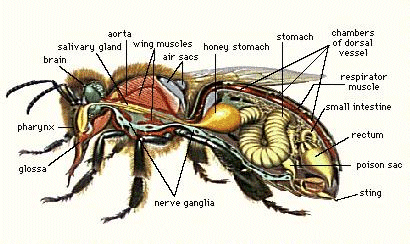
This image is property of galwaybeekeepers.com.
7. Glands
7.1 Salivary Glands
Salivary glands in your head produce saliva that serves multiple functions. It aids in the digestion of carbohydrates, helps create honey, and even plays a role in the construction of wax cells within the hive. Saliva also contains enzymes that break down complex food molecules into simpler components, making them easier to digest.
7.2 Wax Glands
Wax glands located on the underside of your abdomen are responsible for producing the wax used in constructing honeycomb cells. Specialized cells in these glands secrete liquid wax, which solidifies when exposed to air. The bees in your colony then shape and mold the wax into hexagonal cells, providing a sturdy structure for storing honey, pollen, and raising young bees.
7.3 Venom Glands
As a last line of defense, you possess venom glands that produce a potent substance used for stinging. While not all bees possess a stinging ability, those that do can inject venom into potential threats or predators. This venom contains various compounds that can cause pain, inflammation, and even allergic reactions in some individuals.
8. Respiratory System
8.1 Tracheal Tubes
Your respiratory system consists of a network of small tubes called tracheae. These tubes extend throughout your body and deliver oxygen directly to your cells. Oxygen enters your body through openings called spiracles, located along the sides of your abdomen, and travels through the tracheae to reach every part of your body.
8.2 Spiracles
Spiracles are tiny openings on the surface of your abdomen that allow for the exchange of gases. Oxygen enters through the spiracles, while carbon dioxide, a waste product of cellular respiration, is expelled. These openings can be closed or partially blocked when needed, preventing excessive water loss and minimizing the entry of harmful substances.
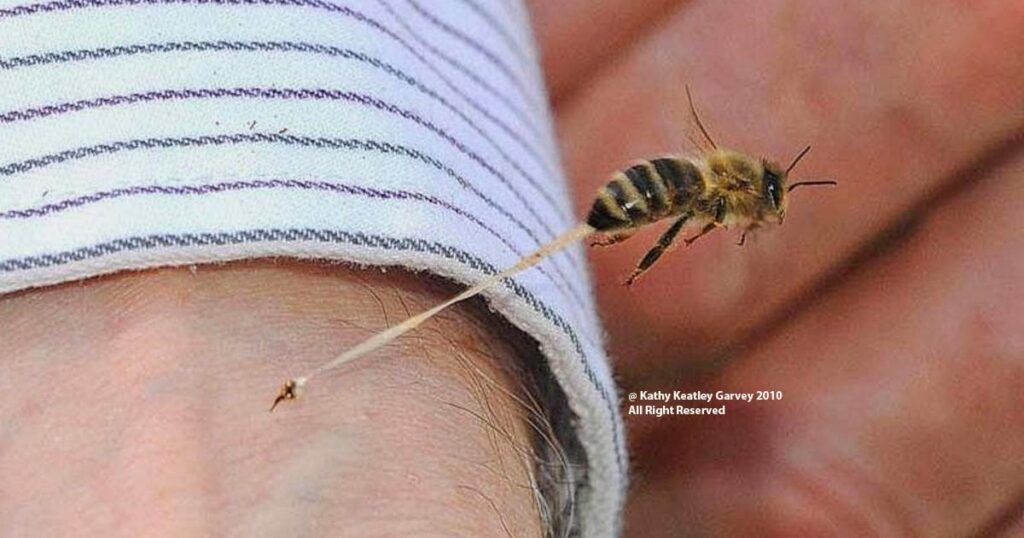
This image is property of www.bensbees.com.au.
9. Circulatory System
9.1 Open Circulatory System
Bees, like other insects, have an open circulatory system. Instead of blood vessels, your body contains a network of interconnected spaces called hemocoel. Hemolymph, a fluid mixture of blood and interstitial fluid, flows through these spaces, bathing your organs and tissues and facilitating the exchange of nutrients and waste products.
9.2 Hemolymph
Hemolymph is the vital fluid that plays a role in transporting nutrients, hormones, and immune cells throughout your body. Unlike in vertebrates, hemolymph does not carry oxygen. Instead, oxygen is delivered directly to your cells through the tracheal tubes. Hemolymph also plays a crucial role in maintaining your body temperature and providing defense against pathogens.
10. Reproductive System
10.1 Queen Bee
The queen bee is the reproductive powerhouse of the colony. She possesses the necessary reproductive organs, including ovaries, to lay eggs. Fertilization occurs outside her body, and she can store sperm for an extended period to fertilize eggs as needed. The queen bee plays a vital role in maintaining the population of the colony by laying eggs and ensuring the survival of future generations.
10.2 Drone Bee
Drones are male bees whose primary function is to mate with the queen. They possess reproductive organs, including testes, which produce sperm. Unlike other worker bees, drones do not have stingers, pollen baskets, or specialized structures for collecting food. Once a drone mates with a queen, it dies, completing its role in the reproductive process.
10.3 Worker Bee
Worker bees, which are female and sterile, make up the majority of the colony. While they do not possess fully functional reproductive organs like the queen, they are still essential for the survival and functioning of the hive. Workers engage in tasks such as foraging for food, tending to larvae, building and repairing the hive, and even defending the colony. Their selfless dedication ensures the success and efficiency of the hive as a whole.
From the fascinating exoskeleton to the intricate reproductive system, the anatomy of a bee is truly remarkable. Each body part, from the head to the abdomen, serves a specific purpose, supporting the unique lifestyle and behaviors of these buzzing creatures. Understanding the anatomy of bees allows us to appreciate their essential role in pollination and the delicate balance of our ecosystems.
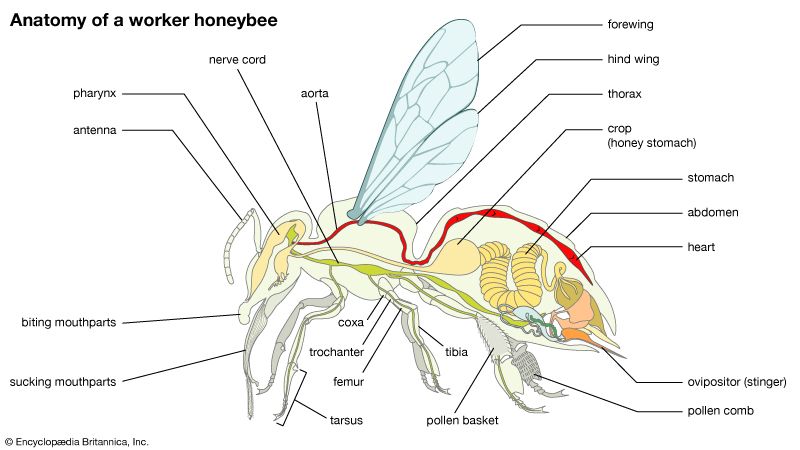
This image is property of cdn.britannica.com.